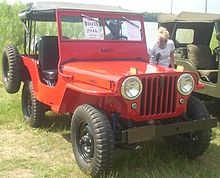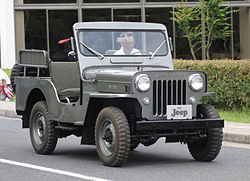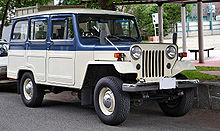- Jeep CJ
-
Jeep CJ 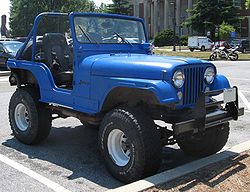
Manufacturer Willys-Overland (1944-1953)
Kaiser-Jeep (1953-1970)
American Motors Corporation (1970-1987)Production 1944-1986 Assembly Toledo, Ohio, United States Successor Jeep Wrangler
Jeep Comanche (For pickup version)Class Compact sport utility vehicle
2-door pickup truckBody style 2-door SUV
2-door convertibleLayout Front engine, rear-wheel drive / four-wheel drive The Willys CJ (later Jeep CJ) (or Civilian Jeep) is a public version of the famous Willys Military Jeep from World War II.
The first CJ prototype (the Willys CJ-2) was introduced in 1944 by Willys, and the same basic vehicle stayed in production through seven variants and three corporate parents until 1986.
A variant of the CJ is still in production today under license. The last CJs, the CJ-7 and CJ-8, were replaced in 1987 by the Jeep Wrangler.
Also available were two-wheel-drive variants, known as DJs.[1]
Contents
CJ-1
Willys-Overland CJ-1 Production 1944 By 1944, the Allies were confident the war would be won. This allowed Willys to consider designing a Jeep for the post-war civilian market. Documentation is hard to come by, but it seems that a Willys-Overland CJ-1 (for "Civilian Jeep-1") was running by May of that year. The CJ-1 was apparently an MB that had been modified by adding a tailgate, drawbar, and a civilian-style canvas top. None of the CJ-1s built have survived, and it is not known (at this writing) how many were built.[2]
CJ-2
Willys-Overland CJ-2 Production 1944-1945 Although it bore the CJ name, the Willys-Overland CJ-2 was not really available at retail. The CJ-2s, also known as "AgriJeeps," were the second generation prototype for the first production civilian Jeep, and were used solely for testing purposes. It was directly based on the military Willys MB, using the same Willys Go Devil engine, but stripped of all military features, particularly the blackout lighting. They had tailgates, Power Take-offs ("PTO"s), engine governors, column-shift T90 manual transmissions, 5.38 gears, 2.43:1 low-range transfer cases, and driver's-side tool indentations. The earlier models had brass plaques on the bonnet and windscreen that read "JEEP". Later models were stamped "JEEP" a la the familiar "WILLYS" stamping that appeared on the CJ-2A and later models. Some CJ-2s had "AgriJeep" plaques affixed to the dash. The spare tire was mounted forward of the passenger-side rear wheel on the earlier models and aft of the rear wheel on later ones. It seems that CJ-2s were distributed to "agricultural stations" for evaluation purposes. Of the 45 CJ-2s built, serial numbers CJ2-06, CJ2-09, CJ2-11, CJ2-12, CJ2-14, CJ2-26, CJ2-32, CJ2-37 and CJ2-39 have survived. Only CJ2-09 has been restored.[2]
CJ-2A
Willys-Overland CJ-2A 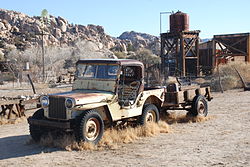
Production 1945-1949 Engine 134CID L-head 60hp I4 Transmission 3-speed manual Wheelbase 80"[3] Length 123.5" Lessons learned with the CJ-2 led to the development of the first full-production CJ, the 1945-1949 Willys-Overland CJ-2A. The CJ-2A looked very much like a civilianized MB with a tailgate and side mounted spare tire. One major difference between the MB and the CJ-2A can be found by looking at the grilles of the two vehicles. The MB had recessed headlights and nine-slot grilles while the CJ2A had larger headlights flush-mounted in a seven-slot grille. In place of the MB's T-84 transmission, the CJ-2A was equipped with the beefier T-90 three speed transmission. However, the CJ-2A was still powered with the reliable L-134 Go-Devil engine. Many of the early CJ-2As were produced using surplus military Jeep parts such as engine blocks and, in a few cases, modified frames. Some of the use of surplus parts was due to strikes at suppliers such as Autolite. Since Willys produced very few parts in-house and relied heavily on suppliers, it was very vulnerable to strikes. Unfortunately for Willys, strikes were very common in the first few years after the war. This undoubtedly contributed to low production totals in 1945 and early 1946.
Since the CJ-2A was primarily intended for farming, ranching, and industrial applications, a wide variety of extra equipment could be purchased with the Jeep. Examples of extra equipment are: rear seat, center rear view mirror(Stock CJ-2As came with only a driver side mirror), front passenger seat (Stock CJ-2As only came with a driver seat), canvas top, front PTO, rear PTO, belt pulley drive, capstan winch, governor, rear hydraulic lift, snow plow, welder, generator, mower, disc, front bumper weight, heavy-duty springs, dual vacuum windshield wipers (stock CJ-2As were equipped with a manual wiper on the passenger side and a vacuum wiper on the driver side), dual taillights (Stock CJ-2As had a taillight on the driver side and a reflector on the passenger side), and hot-climate radiator, driveshaft guards, heater, side steps, and radiator brush guard.
CJ-2As were produced with unique, lively color combinations that in some ways symbolized the hope and promise of postwar America. From 1945 to mid-1946, CJ-2As were only available in two color combinations: Pasture Green with Autumn Yellow wheels and Harvest Tan with Sunset Red wheels. Additional color combinations added in mid-1946 were: Princeton Black with Harvard Red or Sunset Red wheels, Michigan Yellow with Pasture Green, Sunset Red or Americar Black wheels, Normandy Blue with Autumn Yellow or Sunset Red wheels, and Harvard Red with Autumn Yellow or Americar Black wheels. The Pasture Green and Harvest Tan combinations were dropped later in 1946. The Harvard Red combinations were dropped in 1947 and replaced with: Picket Gray with Harvard Red wheels, and Luzon Red with Universal Beige wheels. In 1948, the following color combinations were also added: Emerald Green with Universal Beige wheels, Potomac Gary with Harvard Red or Americar Black wheels. For 1949, the Picket Gray, Michigan Yellow, and Normandy Blue combinations were dropped. Olive drab was also available for export models.
On early CJ-2As, the front seats were covered in olive drab vinyl. Around mid-1947, Slate Gray vinyl became available for certain color combinations. Later, Barcelona Red was added to the mix.
A total of 214,760 CJ-2As were produced.
CJ-3A
Willys-Overland CJ-3A 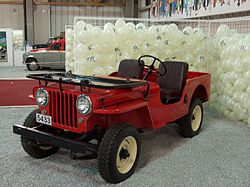
Production 1949-1953 The Willys-Overland CJ-3A was introduced in 1949 and was in production until 1953 when replaced by the CJ-3B. It was powered by Willys' 60 HP L-134 "Go-Devil" 4 cylinder engine, with a T-90 transmission and Dana 18 transfer case, a Dana 25 front axle and Dana 41 or 44 rear axle. It featured a one-piece windshield with a vent as well as wipers at the bottom. The CJ-3A had beefed up suspension (10 leaf) to accommodate the various agricultural implements that were being built for the vehicle.[4] Another difference was a shorter rear wheelwell (the wheelwell from the top front edge to the rear of the body is 32 inches (810 mm) on the 3A compared to 34 inches (860 mm) on the 2A) and moving the drivers seat rearward.[5] A bare-bones Farm Jeep version was available starting in 1951 with a power takeoff. 131,843 CJ-3As were produced before the series ended in 1953. About 550 of the CJ3-A were assembled by Mitsubishi as the J1/J2 in late 1952 and early 1953, exclusively for the Japanese police and forestry agency.[6]
CJ-4
Willys-Overland CJ-4 Production 1951-1953 Wheelbase 81 in (2,057 mm) Only one Willys-Overland CJ-4[7] was ever built as an experimental concept in 1951. It used the new Willys Hurricane engine and had an 81-inch (2,057 mm) wheelbase.
The CJ-4 body tub was an intermediate design between the straightforward raised hood from the CJ-3B and the all new curved body style of the CJ-5.
The design was rejected and the vehicle eventually sold to a factory employee.CJ-3B
Willys CJ-3B 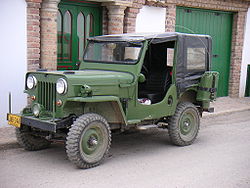
Production 1953-1968 Wheelbase 80"[8] The Willys CJ-3B replaced the CJ-3A in 1953, the same year Willys was sold to Kaiser. Kaiser removed "Overland" from the subcompany name. CJ-3B introduced a higher grille and hood to clear the new Willys Hurricane engine. The CJ-3B was produced until 1968 with a total of about 196,000 [9] produced, although the design was licensed to a number of international manufacturers, including Mitsubishi of Japan and Mahindra of India. Mitsubishi's version was built from 1953 until 1998, while Mahindra continues to produce Jeeps based on the Willys CJ-3B today. The M606 was a militarized version of the Jeep CJ-3B.
Mitsubishi Jeep
Mitsubishi Jeep J-series Manufacturer Mitsubishi Motors Production 1953-1998 Assembly Tokyo, Japan Successor Mitsubishi Pajero Body style 2-door SUV
2-door convertible
4-door station wagonLayout Front engine, four-wheel drive - Japanese wikipedia page on Mitsubishi Jeep
The Jeep was introduced to the Japanese market as the Jeep J3 in July 1953 after Willys agreed to allow Mitsubishi to market the car themselves. The name was not in reference to "CJ3", but rather denoted the fact that 53 "J1"s (CJ3-A with 6-volt electrics) were built for the Japanese regional forest office and circa 500 "J2"s (CJ3-A with 12-volt electrics) were built for the National Safety Forces.[6] Mitsubishi was to continue production of vehicles derived from the CJ-3B design until August 1998, when tighter emissions and safety standards finally made the Jeep obsolete. In total, they built approximately 200,000 units. Short, medium, and long wheelbases were available, as well as a variety of bodystyles and gasoline as well as diesel engines.[10]
The original J3 was a basic, doorless and roofless version, still with left hand drive even though the Japanese drive on the left. The first right-hand drive versions didn't appear until nearly eight years later (J3R/J11R). The original J3 and its derivatives were equipped with the 2.2 L (2,199 cc) F-head "Hurricane" (called JH4 by Mitsubishi, for Japanese Hurricane 4-cylinder) inline four cylinder, originally producing 70 PS (51 kW) at 4,000 rpm.[11] In 1955 a slightly longer wheelbase J10 which could seat six was added, and in 1956 the J11 appeared, a two-door "delivery wagon" with a full metal body. This was considerably longer, at 433 cm (170 in) versus 339 cm (133 in) for the J3.
Local production of the JH4 engine commenced in 1955. A locally developed diesel version (KE31) was introduced for the JC3 in 1958, originally with 56 PS (41 kW) at 3,500 rpm but with 61 PS (45 kW) at 3,600 rpm a couple of years later.[11] By 1962, the output of the gasoline JH4 engine had crept up to 76 PS (56 kW). By the time of the introduction of the longer J20 in 1960, a six seater like the J10 but with a differently configurated (more permanent) front windshield as well as available metal doors, Mitsubishi had also added small diagonal skirts to the leading edge of the Jeep's front fenders. This style was to remain the last change to the sheetmetal up front until the end of Mitsubishi Jeep production in 1998.
CJ-5
Willys CJ-5/Jeep CJ-5 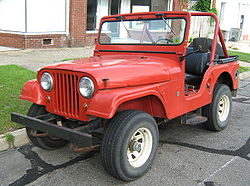
CJ-5 with V6 engineAlso called Jeep Shahbaz (Pars Khodro)[12] Production 1954-1983 Engine Willys Hurricane F-head I4
192 cu in (2.3 L) Perkins Diesel I4
225 cu in (3.7 L) Dauntless V6
151 cu in (2.5 L) Iron Duke I4
232 cu in (3.8 L) AMC I6
258 cu in (4.2 L) AMC I6
304 cu in (5.0 L) AMC V8Transmission 3-speed manual
4-speed manualWheelbase 81 in (2,057 mm) (1954-1971)
83.5 in (2,121 mm)[13] (1972-1983)Length 138.2 in (3,510 mm) Width 68.5 in (1,740 mm) Height 67.7 in (1,720 mm) Curb weight 2,665 lb (1,209 kg)[14] Related Jeep DJ-5 The Willys CJ-5 (after 1964 Jeep CJ-5) was influenced by new corporate owner, Kaiser, and the Korean War M38A1 Jeep. It was intended to replace the CJ-3B, but that model continued in production. The CJ-5 repeated this pattern, continuing in production for three decades while three newer models appeared. "The CJ-5 has the distinct honor of being a vehicle that was hard to kill off... equaling the longest production run of note."[15] A total of 603,303 CJ-5s were produced between 1954 and 1983.
From 1961 to 1965, optional for the CJ-5 and CJ-6 was the British-made Perkins 192 cu in (2.3 L) Diesel I4 with 62 gross horsepower (46 gross kW) at 3000rpm and 143 gross torque at 1350rpm. [16]
In 1965, Kaiser bought the casting rights to the Buick 225 cu in (3.7 L) V6 Dauntless and the CJ-5 and CJ-6 got a new engine with 155 hp (116 kW) supplementing the four-cylinder Willys Hurricane engine.
A similar model, the Jeep DJ, was based on the CJ.
The company was sold to American Motors (AMC) in 1970, and the GM engine was retired after the 1971 model year. (GM's Buick division repurchased the engine tooling in the early 1970s which served as the powerplant in several GM vehicles.) The "Trac-Lok" limited-slip differential replaced the "Powr-Lok" in 1971.
American Motors began using their own engines in 1972. Replacing the Hurricane was the one-barrel 232 cu in (3.8 L) (except in California). Optional was a one-barrel 258 cu in (4.2 L) (standard in California). Also in 1972, AMC's 304 cu in (5.0 L) V8 engine became available in the same tune as a base V8 muscle car. To accommodate the new engines the fenders and hood were stretched 5 inches (127 mm) starting in 1972 and the wheelbase was stretched 3 inches (76 mm). Other drive train changes took place then as well, including the front axle becoming a full-floating Dana 30.
In 1976 the tub and frame were modified slightly from earlier versions. The windshield frame also changed meaning that tops from 1955-1975 will not fit a 1976-1983 CJ-5 and vice-versa.
In 1979, the standard engine became the 258 cu in (4.2 L) I6 that now featured a two-barrel carburetor.
From 1980 to 1983, the CJ-5 came standard with a "Hurricane"-branded version of the GM Iron Duke I4.
Several special CJ-5 models were produced:
- 1961-1963 Tuxedo Park Mark III
- 1965 "Tuxedo Park Mark IV"
- 1969 Camper[17][18][19][20][21][22]
- 1969 462
- 1970 Renegade I
- 1971 Renegade II
- 1972-1983 Renegade Models — featuring a 304 cu in (5.0 L) V8, alloy wheels, and a Trac-Lok limited-slip differential
- 1973 Super Jeep
- 1977-1983 Golden Eagle
- 1979 Silver Anniversary
Early Tuxedo Park models were trim lines, but the Tuxedo Park Mark IV was claimed as a separate model than the other CJ series (marked in 1965 as the "Universal"), with more differences than past models. The Tuxedo Park Mark IV was an attempt to crack the mass market; it was, according to Jeep, “a new idea in sports cars ... the sportiest, most FUNctional car on the automotive scene.” It added to the standard CJ chrome bumpers, hood latches, gas cap, mirror, and tail lamp trim. 81 and 101 inch wheelbases were available, with a variety of convertible top and seat colors, and front bucket seats in “pleated British calf grain vinyl.” Sales of this model, introduced in 1965, were low.[23]
In Australia, a unique variant of the CJ5/CJ6 was produced in limited numbers. In 1965, when the CJ was given the all-new Buick V6, Jeep saw the need for something similar in Australia. As such, they began to fit Falcon 6 cylinder engines to them at their Rocklea factory in Queensland. The jeep was fitted with an engine, pedal box and clutch/brake system corresponding to the equivalent Falcon at the time; i.e. a 1965 CJ5 would be fitted with 1965 Falcon engine/clutch components. When the Falcon received a hydraulic clutch system, so too did the Jeep. Combat 6 jeeps were also fitted with Australian Borg Warner differentials, and Borg Warner brand gearboxes. Unfortunately there is very little documentation about these jeeps, and often the only way to conclusively identify them is by owner history. Web page describing Jeep's presence in Australia, including the "Combat 6"
CJ-6
Willys CJ-6/Jeep CJ-6 Production 1955-1975 Engine Willys Hurricane F-head I4
Perkins Diesel
225 cu in (3.7 L) Dauntless V6
151 cu in (2.5 L) Iron Duke I4
232 cu in (3.8 L) AMC I6
258 cu in (4.2 L) AMC I6
304 cu in (5.0 L) AMC V8Wheelbase 101 in (2,565 mm) (1955-1971)
104 in (2,642 mm) (1972-1981)The CJ-6 was simply a 20-inch (508 mm) longer-wheelbase (101 in, 1955-1971 - `04 in, 1972-1981) CJ-5. Introduced in 1955 as a 1956 model, the CJ-6 was never very popular in the United States. Most CJ6 models were sold to Sweden and South America. The U.S. Forest Service put a number of CJ-6 Jeeps in to use. American sales ended in 1975. Just 50,172 had been made when the series went out of production completely in 1981. Just as in the CJ-5, the V6 and V8 engine choices appeared in 1965 and 1972. Former President Ronald Reagan owned a CJ-6 and used it on his California Ranch.[24]
The Military version, the M-170, actually entered production in 1953. It shares many of the features of the M38A1 (Military CJ-5), but had the passenger door opening extended back to the rear wheel well. Most were used as front-line field ambulances, able to carry 4 litters. A few were also used as radio units.CJ-5A and CJ-6A
CJ-5A & CJ-6A Production 1964-1968 From 1964-1968 Kaiser elevated the Tuxedo Park from just a trim package to a separate model for the CJ-5A and CJ-6A. A Tuxedo Park Mark IV is signified by a different prefix from a normal CJ-5 with a VIN prefix of 8322, while a normal CJ-5 VIN prefix is 8305 from 1964-1971.
CJ-7
Jeep CJ-7 
Production 1976-1986 Engine 150 cu in (2.5 L) AMC I4
151 cu in (2.5 L) GM Iron Duke I4
232 cu in (3.8 L) AMC I6
258 cu in (4.2 L) AMC I6
304 cu in (5.0 L) AMC V8
145 cu in (2.4 L) Isuzu Diesel C240Transmission 5-speed manual
4-speed manual
3-speed automatic />3-speed manualWheelbase 93.3 in (2,370 mm) Length 148 in (3,759 mm) Width 68.5 in (1,740 mm) Height 67.7 in (1,720 mm) Curb weight 2,707 lb (1,228 kg)[25] The Jeep CJ-7 featured a longer wheelbase than the CJ-5 and lacked the noticeable curvature of the doors previously seen on the CJ-5. The other main difference to the CJ-5 was to the chassis which hitherto consisted of two parallel longitudinal main c-section rails. To help improve vehicle handling and stability the rear section of the chassis stepped out to allow the road springs and dampers to be mounted closer to the outside of the body. It was introduced in 1976 and 379,299 were built during 11 years of production.
The CJ-7 featured an optional new automatic all-wheel drive system called Quadra-Trac, as well as a part-time two speed transfer case; an automatic transmission was also an option. Other features included an optional molded hardtop, and steel doors. The CJ-7 was also available in Renegade and an upgraded Laredo model. Noticeable by their different body decals, the Laredo model featured nicer seats, steering wheel tilt, and a chrome package that included the bumpers, front grill, and mirrors. An optional Trak-Lok differential was available for the rear. Rear axle ratio typically 3.54, but later went up to 2.73.
The reports of the CJ7 were different in each type of engine: the 2.4 liter diesel was mated to the short 4.10 axle (in both Renegade and Laredo), while the 4.2 and 2.5 straight sixes used 3.73 and AMC V8 304-powered models (produced 1976-1981, which became part of the Golden Eagle version) used 3.55.
From 1976 to 1980 was mounted a Dana 20 transfer case, Dana 30 front axle (27- or 31-spline), and an 29-spline AMC 20 rear axle, while in recent years, Laredo package added tachometer, chrome bumpers, tow/recovery hooks and interior, comfortable leather seats, and clock. In 1980, the Laredo was first fitted with an AMC model 20 rearend until mid year 1986 when it was equipt with a dana 44 and all 1980 and newer cj7s came with the Dana 300 transfer case; parts for the 300 are still in production and the case is sought after by lovers of off-road due to its durability and upgradability.
During its 11 years, the CJ-7 had various equipment packages:
- Renegade 1976-1986 (2.4D L6-2.5-4.2-5.0 AMC 304 V8)
- Golden Eagle 1976-1979 (5.0 AMC 304 V8)
- Laredo 1982-1986 (2.4D-4.2 l6)
- Jamboree Edition (Limited Edition 2500 models which were built for the 30th anniversary 2.5 and 4.2)
A diesel-powered version was made in the Ohio factory for export only. The engines were provided by General Motors, the owners of Isuzu Motor Cars. Production of this diesel version is believed to have been only between 1980 and 1982. This model had the Isuzu C240 engine, T176 transmission, Dana 300 transfer case although there are reports of some being produced with the Dana 20. Typically they had 4.1 ratio, narrow track axles.
The CJ-7 continues to be used in the sport of mud racing, with either the stock body or a fiberglass replica. It is also a favorite for rock crawling.
Engines
- 150 cu in (2.5 L) AMC I4
- 151 cu in (2.5 L) GM Iron Duke I4
- 232 cu in (3.8 L) AMC I6
- 258 cu in (4.2 L) AMC I6 99.4 PS (73 kW; 98 hp), 261 N·m (193 lb·ft)
- 304 cu in (5.0 L) AMC V8 127 PS (93 kW; 125 hp), 296 N·m (218 lb·ft)[25]
- 145 cu in (2.4 L) Isuzu Diesel C240
Transmissions
- Warner T-18 (4 speed married to the dana 20 1976-1979) (adapters exist to marry it to a dana 300 but it was not an option)
- Borg-Warner T-4 (4 speed married to dana 300)
- Borg-Warner T-5 (5 speed married to dana 300)
- Tremec T-150 (3 speed Manual transmission married to dana 20 1976-1979)
- Tremec T-176 (4 speed manual married to dana 300)
- Borg-Warner SR-4 (4 speed married to dana 300)
- GM TH-400 (3 speed married to BW QuadraTrac #1339)
- Chrysler TF-999 (3 speed automatic transmission - 4.2L married to dana 300)
- Chrysler TF-904 (3 speed automatic transmission - 2.5L married to dana 300)
Transfer Cases
- Dana 20 (1976–79)
- Dana 300 (1980–86)
- Borg-Warner QuadraTrac #1339 (1976–1979)
Axles
- Dana 30 Front narrow track (1976–1981)
- Dana 30 Front wide track track (1982-1986)
- 2-Piece AMC 20 Narrow track Rear (1976–1981)
- 2-Piece AMC 20 Narrow track offset pumpkin Rear (1976–1979) For QuadraTrac #1339 equipt jeeps only
- 2-Piece AMC 20 Wide track Rear (1982–1986)
- Dana 44 Wide track Rear (mid year 1986)
CJ-8 (Scrambler)
Jeep CJ-8 Scrambler 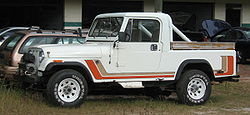
Production 1981-1986 Body style 2-door pickup truck Transmission 5-speed manual
4-speed manual
3-speed automaticWheelbase 103 in (2,616 mm) The Jeep CJ-8 was a long wheel-base version of the CJ-7, introduced in 1981. It featured a 103-inch (2,616 mm) wheelbase and a removable half-cab, creating a small pick-up style box instead of utilizing a separate pickup bed. Only 27,792 were built in the five years of production before being replaced by the similarly sized Comanche.
CJ-8s used the traditional transfer case and manual front-locking hubs to engage the four-wheel drive. Most had a four- or five-speed manual transmission, but a three-speed automatic transmission was an option.
Many CJ-8's were equipped with the "Scrambler" appearance package which included tape graphics and special wheels.
A full length steel hardtop CJ-8 was made for the Alaskan Postal Service, using right hand drive and automatic transmissions. Instead of the rear tailgate, the steel hardtop utilized a hinged barn door opening to the back. There were only 230 produced and sold in the U.S. It was also widely sold in Venezuela and Australia as the CJ8 Overlander, with small differences including full length rear windows on the Overlander.[26] Steel hardtops used on these postal Scramblers and Overlanders were known as "World Cab" tops.[27]
CJ-10
Jeep CJ-10 Link to Jeep CJ-10 image Production 1981-1985 Body style 2-door pickup truck Engine Nissan SD33 3.3L Diesel or AMC 258 Petrol
The Jeep CJ-10 was a CJ-bodied based pickup truck that had a modified J series chassis. Produced from 1981 through 1985, it was sold mainly as an export vehicle. They featured square headlights mounted in the fenders and a 9-slot grille, a homage to the old Jeeps of WWII which originally had a 9 slot grille (the civilian model, the CJ-2 and 2a, were given a 7 slot grille as a distinction between the military and civilian models). These were equipped with either a Nissan 3.3 diesel, or a 258 AMC engine. The driveline consisted of a Tremec T177 4 speed or 727 automatic and a New Process 208 transfer case and a Dana 44 front differential and Dana 60 rear differential.CJ-10a
Jeep CJ-10a Link to CJ-10a image Production 1984-1986 Body style 2-door flightline aircraft tug Engine Nissan SD33 3.3L Diesel The Jeep CJ-10a was a CJ10-based flightline aircraft tug. Produced in Mexico from 1984 through 1986, were used by the United States Air Force for use as an aircraft pulling vehicle. About 2300 of them were produced.
See also
- Jeep Wrangler (replacement for the CJ series in 1987)
Notes
- ^ Flory, J. "Kelly", Jr. American Cars 1960-1972 (Jefferson, NC: McFarland & Coy, 2004), p.412.
- ^ a b "The CJ2A Story". Thecj2apage.com. http://www.thecj2apage.com/story.html. Retrieved 2010-09-29.
- ^ "Directory Index: Jeep/1949_Jeep/1949_Jeep_Universal_Operation_Data". Oldcarbrochures.com. http://www.oldcarbrochures.com/static/NA/Jeep/1949_Jeep/1949_Jeep_Universal_Operation_Data/1949%20Jeep%20Universal-20.html. Retrieved 2011-11-20.
- ^ Cary, Reed. "The CJ-3A Universal Jeep", retrieved on 2009-09-28.
- ^ "The CJ-3A", retrieved on 2009-09-28.
- ^ a b Ozeki, Kazuo (2007) (in Japanese).
日本のトラック・バス 1918~1972 [Japanese Trucks and Buses 1918-1972:]. Tokyo: Miki Press. p. 131. ISBN 978-4-89522-494-9. - ^ Holland, Bob (2008-03-21). "Jeep's mystery CJ4". Blogs.edmunds.com. http://blogs.edmunds.com/straightline/2008/03/jeeps-mystery-cj4.html#more. Retrieved 2010-09-29.
- ^ "Directory Index: Jeep/1962_Jeep/1962_Jeep_CJ-3B_Brochure". Oldcarbrochures.com. http://www.oldcarbrochures.com/static/NA/Jeep/1962_Jeep/1962_Jeep_CJ-3B_Brochure/1962%20Jeep%20CJ-3B-03.html. Retrieved 2011-11-20.
- ^ Redmond, Derek (2004-11-11). "A Brief History of the CJ-3B". Film.queensu.ca. http://www.film.queensu.ca/cj3b/History.html. Retrieved 2010-09-29.
- ^ Redmond, Derek (2010-05-01). "Jeeps in Japan". Film.queensu.ca. http://www.film.queensu.ca/Cj3b/World/Japan2.html. Retrieved 2011-05-05.
- ^ a b Ozeki, p. 140
- ^ http://web.parskhodro.ir/pdf/Parskhodro%20history.pdf
- ^ DeLong, Brad. 4-wheel Freedom. Paladin Press. ISBN 0-87364-891-9.
- ^ "1979 Jeep CJ-5 car technical specifications from Carfolio.com - 0 door 4.2 litre (4235 cc) Inline 6 99.4 PS, 2X3 speed manual". Carfolio.com. http://www.carfolio.com/specifications/models/car/?car=58322. Retrieved 2010-12-03.
- ^ Tellem, Tori. History of the CJ-5 - Jeep Autopsy: CJ-5 One Of The "Unstoppables" JP Magazine, retrieved on 2009-08-15.
- ^ "Engine Specs - Jeep Engines". Baeta.org. http://www.baeta.org/opie/engine.htm#P. Retrieved 2011-11-20.
- ^ http://www.street2mud.com/albums/album02/JeepCJ5Camper_5.jpg
- ^ http://www.street2mud.com/albums/album02/JeepCJ5Camper_6.jpg
- ^ http://www.street2mud.com/albums/album02/JeepCJ5Camper_7.jpg
- ^ http://www.street2mud.com/albums/album02/JeepCJ5Camper_8.jpg
- ^ http://www.street2mud.com/albums/album02/JeepCJ5Camper_9.jpg
- ^ http://www.street2mud.com/albums/album02/JeepCJ5Camper_10.jpg
- ^ "Jeep for 1965". Allpar. http://www.allpar.com/trucks/jeep/1965.html. Retrieved 2008-09-24.
- ^ Gipper "CJ-6 April 1984" Ray's Jeeps FAQs, 2005, retrieved on 2008-09-17.
- ^ a b "1979 Jeep CJ-7 car technical specifications from Carfolio.com - 0 door 4.2 litre (4235 cc) Inline 6 99.4 PS, 2X3[clarification needed] speed manual". Carfolio.com. http://www.carfolio.com/specifications/models/car/?car=58366. Retrieved 2010-12-03.
- ^ Jeep Overlander CJ-8 Specifications and Dimensions. Jeep Australia press release, c1984.
- ^ CJ10 technical manual
External links
Type 1940s 1950s 1960s 1970s 5 6 7 8 9 0 1 2 3 4 5 6 7 8 9 0 1 2 3 4 5 6 7 8 9 0 1 2 3 4 5 6 7 8 9 Traditional CJ-2A CJ-3A CJ-5 CJ-3B CJ-7 CJ-6 Dispatcher DJ-3A DJ-5/6 Compact SUV VJ C101 C104 SUV Willys Jeep Wagon Jeep Cherokee (SJ) Wagoneer SJ Compact pickup Commando Full-size pickup Willys Jeep Truck Gladiator Honcho/J10-20 Series Truck Forward Control Van FJ-3/3A Type 1980s 1990s 2000s 2010s 0 1 2 3 4 5 6 7 8 9 0 1 2 3 4 5 6 7 8 9 0 1 2 3 4 5 6 7 8 9 0 1 2 Traditional CJ-5 CJ-7 Wrangler YJ Wrangler TJ Wrangler JK CJ-8 LJ Dispatcher DJ-5/6 Compact Crossover Compass MK Patriot MK Compact SUV Cherokee / Wagoneer XJ Liberty KJ Liberty KK Medium-size SUV Cherokee (SJ) Grand Cherokee ZJ Grand Cherokee WJ Grand Cherokee WK Gr. Ch. WK2 Wagoneer SJ Grand Wagoneer SJ ZJ Commander XK Compact pickup CJ-10 Comanche MJ Full-size pickup Honcho/J10-20 Series Categories:- Jeep platforms
- Jeep vehicles
- Willys vehicles
- American Motors
- Compact SUVs
- Pickup trucks
- Vehicles introduced in 1944
- Motor vehicles manufactured in the United States
Wikimedia Foundation. 2010.

